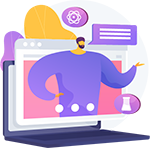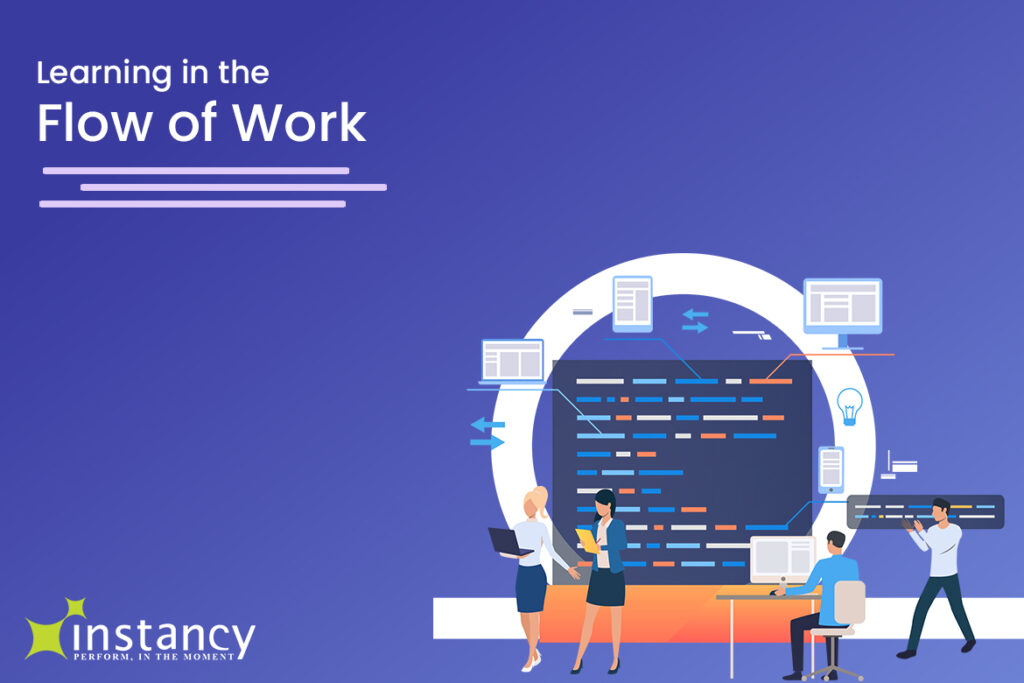Learning in the flow of work heralds a new paradigm in workplace learning and skill development. Fostering a culture of learning within the workplace where learning is ongoing, embedded, and always available brings in many unexpected benefits. The prospect of learning as you grow in the workplace ushers in an enhanced sense of engagement and commitment.
Learning in the flow of work is about making learning more relevant, embedded, and effective in an individual’s day-to-day job. Microlearning or bite-sized learning can happen while you are performing a work task or taking a short break from work.
The ability to connect with a colleague or a subject matter expert to seek help on specific work-related queries or learning about a topic related to executing a certain job task becomes feasible. Learning can happen within the work environment or business chat applications.
For example, learning may be assessed within chat and work collaboration apps like Microsoft Teams. Learning can be pushed to the knowledge worker automatically using artificial techniques based on the work tasks being performed.
Learning in the flow of work is not just a theoretical concept, but it is a reality to reckon with. It is primarily the flexibility and effectiveness of learning in the flow of work that is gaining traction among cutting-edge companies.
Shortening the distance between information and its consumption for learning facilitates a seamless flow of relevant content eliminating productivity pitfalls and gaps that are mostly inevitable when businesses stop learning something new. With learning which is a perennial process that occurs within the system, both your employees and the external audiences are always armed with updated information that is required to fuel peak performance.
What is Learning in the Flow of Work?
Learning in the flow of work is an amalgam of quick and easy access to a short piece of learning content or answers to questions while on the job. It is all about integrating traditional forms of learning (learning online) with this concept of learning in the flow of work. Lifelong learning has become an accepted economic imperative.
Opportunities for development ushers in workplace contentment, by fueling the inherent human need to look for ways to do things better. Learning in the flow of work recognizes that for learning to happen it has to fit and align with working days and working lives.
What do people typically learn within their work context? While all of us can learn online and in many environments such as a workplace, for many employees the requirement is to learn face to face with others in a work context. This informal learning that employees engage in and apply immediately to the tasks at hand makes learning in the flow of work a reality.
Why is Learning in the Flow of Work Important?
Learning shall continue to be the core of progress and adaptability. The mode of learning such as monthly and annual workshops and training classes are in the current context both redundant and irrelevant. It is commonly noticed that everyone complains of the lack of time. This brings us to the reason why the majority of people today want to learn in the flow of work.
For companies, this potentially means building a single integration platform that factors in the needs of their teams and stacks it in one place making it accessible at all times. This obliterates obstacles such as busy schedules, remote workplaces, and the like providing every team member with the right support at the right time. This robust integration ushers in optimized processes, lend insights into potential disruptions and pave the way for data-driven strategic level decision making.

Learning in the workflow allows the employee to be more proactive, this enables taking ownership of their performance, keeps them motivated, and helps them achieve both personal and job-related goals This learning in the flow of work makes the process of learning natural and unobtrusive. Employee engagement decreased turnover and improved employee productivity are a natural consequence of learning in the workflow.
While formal learning processes are fairly time-consuming, learning in the workflow makes learning content both contextual and convenient. New employees can focus on what they need to know and when they need to know irrespective of where they are.
Experienced employees have the advantage of reviewing their skills and figure if their knowledge needs to be refreshed. This plays out in a way that makes for substantial savings in time and clearly, everyone wins. Learning is potentially embedded into a platform in which employees work, wherein the systems can coach and train employees to perform better at their jobs.
Making Learning Proactive – Some Examples
Learning in the flow is about making learning proactive so we push the right knowledge to the right person at the right time.
- For example, a short procedure with step-by-step instruction is presented when needed.
- A manager is scheduled to evaluate an employee’s performance, an alert with a link to evaluation criteria, and the process is pushed to the manager’s device so the manager can make the observations correctly.
- In another example, a link to microlearning with a customer case study is pushed to a sales rep device before an important sales appointment with a prospect.
Capturing Knowledge Proactively
But learning in the flow is not just about pushing the existing knowledge to the knowledge workers, it is also about building knowledge. For example, a Solution Architect is prompted to capture key knowledge so it can be indexed, searched, or pushed to others when needed. tur adipiscing elit. Ut elit tellus, luctus nec ullamcorper mattis, pulvinar dapibus leo.
Enabling Intelligent Searches
A user can search for any topic related to their work and a learning system can help aggregate documents, videos, microlearning, and related peers or experts within the organization are resources.
Intelligent Content Curation
The learning experience platform curates the content being generated within the organization and through external resources and provides a knowledge feed for each individual.
Ubiquitous Access
The learning in the flow is more effective because it provides knowledge access dynamically and quickly no matter what device is being used. The knowledge resources can be also served as alerts or actionable links within business chat applications like Microsoft Teams, chatbots (conversational apps).
How Does Learning Happen in the Flow of Work?
It is amply clear that learning in the flow of work enables creating opportunities for learning to happen whenever an employee is up for its consumption. There are potentially five ways of making this happen.
1. Clarity:
Keeping your eye on the reward, figuring a way to help the community grow is critical. The growth of an organization is always in the direction of what people study, hence creating clear and simple but lucid lists of both human and technical skills that are needed to accomplish growth will help people curate the right content with the right intent. Creating clear and simple learning paths within a specific job role empowers and prepares them in paving their way forward.
2. Relevance:
The recent past has seen a phenomenal rise in content platforms. When a content platform is typically powered by machine learning, information gets hyper-specific and extremely interesting. Micro skills are enhanced through real work experiences without the need to step away from work for a sizeable chunk of time.
3. Cultivate reflection:
While experiences do contribute to learning, it is reflecting on them that takes the learning notches higher. This focuses on the cultural components of how people learn. The most effective way to accomplish this is by encouraging questions on “How did that work for you?” or “What is your take from this experience?”. This potentially triggers an automatic reflection on what just happened.
4. Peer learning:
This is a great way of not just enabling learning in the flow of work but also works in parallel towards building trust, efficiency, and productivity, focusing on a few key areas that are integral to making the most positive impact along with empowering and enabling employees to share, teach and coach within their flow of work.
5. Blending:
The blending of different modalities paves the way for great learning. Co-creating and curating the right and relevant learning trajectories will help unlock individual potentials while serving the needs of the enterprise. To ensure learning happens with ease in the flow of work it has to work on the principle of one size fits one.
Learning in the flow is facilitated and enhanced by the following tools or technologies:
- The volume of information and complexity of knowledge needed in today’s work scenarios is far too large to commit to long-term memory. Therefore, computer-assisted knowledge and performance support are necessary for optimal job performance. This fact was recognized many decades ago and a ‘performance support’ movement was started within the ‘Training’ industry. However, the enabling technologies to make this happen in a scalable way are only now becoming available.
- Web and mobile apps are being used for a wide variety of job tasks daily. These applications can be integrated with many new technologies and infrastructure services. Artificial intelligence, fast content indexing technologies, data integration interfaces, big data comprising of structured and unstructured information are all components and underlying systems that will help achieve the goal of intelligent learning and performance support in the flow.
Instancy’s collaboration software can be thought of as a map that points to the work of the colleagues who are sharing information relevant to a certain task and also points out links on the websites on the Internet for additional information. Through repeated actions performed within a task, a user accumulates contextual knowledge which makes the task easier to perform.
How to Ensure Learning is Happening in the Flow of Work?
Having understood the indisputable benefits of learning in the flow of work, ensuring that the learning continues to happen is the next most important task at hand. We will look at this from a dual perspective, that is to say from the perspective of the individual and then from the organization’s perspective.
Bottom-up Learning
Here’s a look at what an individual with an appetite for learning in the flow of work will look at:
1. Metacognition and mindfulness:
Being invested in the understanding of what’s going on at work enhances the ability to learn and develop. Being mindful and observant of tactics and techniques, taking a keen interest in product features, industry trends, and feedback on presentation skills helps in keeping the individual at the top of the game in terms of enhanced skills and engagement with colleagues.
2. Maintain a to learn list:
Listing concepts, thoughts, practices, and vocabulary that the individual can intend to delve into, by bookmarking them on the browser to explore when they have a few moments to reflect is a personal and rewarding experience.
3. Learning channels:
Contributing actively to a learning channel and helping people understand the intent for sharing the same helps peel the layers of what it is about and why it matters. Not only does this help others and benefit the company but helps accelerate the individual’s learning.
Top-down Learning
This section focuses on what organizations need to do to ensure better use of the flow of work to help develop the skills of their workforce.
1. Easy to use corporate knowledge systems:
Spending time curating and fixing the internal systems will ensure that the search results are on point and useful. This is possible only if the content is well tagged and maintained and cleaned up from time to time to keep it relevant.
2. Sharing content internally:
Technology can harness the learning that is happening in one part of the company and scaling its benefits to others. Data sharing can be algorithmically spotted, tagged, and redistributed to a larger audience for consumption.
3. Leveraging APIs for content:
Interoperability is key when building software, which is often delivered through APIs. Integrative technologies and learning-oriented APIs can help with the ushering in of relevant learning content. This helps unleash the purest form of learning in the flow of work that stretches beyond a simple application integration and promises a superbly rich training experience.
4. A dedicated learning channel or portal or embedded with business collaboration apps like MS Teams:
A dedicated online learning space with meaningful contributions from business leaders encourages naturally active sharers and influencers to post and promote new content that reinforces the message that learning is indispensable.
5. A conversational or chatbot interface:
A chatbot layer added to the primary workflow software is an effective way to pair learning with work. The more relevant the chatbot is to what is happening on the ground and in the workflow, the more useful it will be.
Education and learning and also professional learning needs to be made seamless so that students and learners can view the information, videos, podcasts, and webinars relevant to their jobs or for the knowledge and information they seek. Instancy’s learning experience platform integrated with Microsoft Teams helps create enhanced on-point and relevant learning and subsequently share this learning around the work community.
Conclusion
With most companies becoming more invested in employee engagement and wellbeing, the concept of learning in the flow of work has resonated with chief learning officers globally. With the rapidly changing markets, experimentation, feedback, and the ability to adapt are imperative prerequisites.
To keep up the pace people must learn faster and that is achieved by focusing more on the immediate business context, easy access to information, performance support aids, and relevant and curated training that can be directly applied to work. Learning in the flow of work is leveraged by all business leaders today, as every organization stands to benefit from this.
We have discussed some of the elements involved in learning and how technology is transforming, how we can learn, and how technology facilitates the process of learning. In this article, we have also explored how machine learning and artificial intelligence can be leveraged to help us learn faster and better.
Therefore, with the help of technologies like chatbots, voice-activated AI assistants, and machine learning we can enhance the learning outcome and help employees become more productive in their work lives. Sounds exciting? So, what are you waiting for? Sign up for a demo today.




